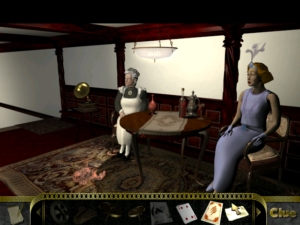Clue Chronicles: Conclusion
I’ve been a little defensive about Clue Chronicles: Fatal Illusion, trying to see the best in it and focus on what it does right, so let me be completely clear: This is not a good game. Even starting from “It’s based on a board game IP”, I think it’s disappointing, because the story doesn’t involve all of the characters from the game in a satisfying way. By the end, the only ones that are at all relevant are Mr. Green and Miss Scarlet. I feel like what we have is a truncated version of a larger and more ambitious design with more murders in it.
But I can’t complain much about truncation, because it spares us more of the puzzles. I wound up seeking hints for three, and brute-forcing combinations on a fourth — that one being the game’s climactic puzzle, placing gems to match hieroglyphs. One placement, Miss Scarlet’s red gem to match “Nefer, the symbol of beauty”, seemed very clear, but who gets “Was – Sceptre, the symbol of power” and who gets “Bow – Junet, pedjet, used against the many enemies”? Also, I found that a lack of clarity in the graphics sometimes got in the way of proper solving. The game runs at 640×480, which would be easily enough to display the various symbols and diagrams in the game well if they were hand-drawn pixel art, but not with 1990s 3D models.
Speaking of 3D art, there are frequent problems with the animation, especially as it goes on. Movement animations frequently don’t match the still images; objects will disappear while you’re moving and reappear when you stop, and such. Sometimes you can see a still version of a character as part of the room image behind their animated self. There are a few animations that are swapped, so that pushing a lever right shows the animation of pushing it left and vice versa. Things like that. Things that clearly show that meeting a contractual deadline was top priority.
Every once in a while, someone at Hasbro decides that the reason people aren’t buying Clue as much as they used to is that it’s dated, and they try to modernize it. And it always seems like a mistake, because evoking the bygone era of Agatha Christie novels is part of the point. Clue Chronicles, to its merit, avoids this mistake, setting the whole thing shortly before the Second World War, and working that fact into some of the extra characters: one is rumored to be a German spy, another to be a Soviet spy. This is never expanded upon, and is irrelevant to the story. It’s all very well to have red herrings, but the international intrigue angle doesn’t even get enough attention to qualify as a distraction. It reminds me of certain tabletop role-playing campaigns I’ve been in, where people write backgrounds on their character sheets and then forget about them.
But it also supports the truncation theory. This really seems like a game whose initial design document far exceeded its budget. The initial concept was, after all, essentially budgetary: “We already have these character models built, so let’s use them again!” But then what do they do? Double the cast.
 Comments(0)
Comments(0)